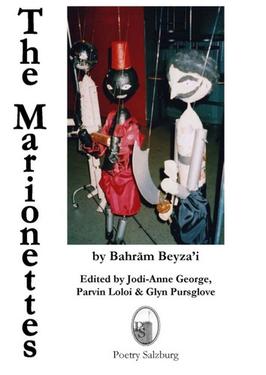Bukhara magazine is a Persian-language magazine published in Tehran and edited by Ali Dehbashi. The magazine began publication in 1998 and is published on a monthly basis. The content consists of scholarly articles on Persian history, art, philosophy, literature, culture, and Iranology. The magazine has published several special issues on great world authors such as Rabindranath Tagore, Günter Grass, Osip Mandelstam, Umberto Eco and Virginia Woolf.

Bahrām Beyzāêi is an Iranian playwright, theatre director, screenwriter, film editor, and ostād ("master") of Persian letters, arts and Iranian studies.

Iraj Afshar was a bibliographer, historian, scholar, professor, and an iconic figure in the field of Persian studies. Afshar was a professor emeritus of the University of Tehran. He was a consulting editor of Encyclopædia Iranica at Columbia University.
Persian theater goes back to antiquity. The first initiation of theater and phenomena of acting can be traced in ceremonial theaters to glorify national heroes and legends and to humiliate the enemy, as in the classics "Soug Sivash" and "Mogh Koshi" (Megakhouni). Ancient Persian theatre and dance was significantly researched by the Greek historian Herodotus of Halikarnassos, who lived during the Persian rule in Greece. In his work Book IX (Calliope), he describes the history of Asian empires and also the Persian wars until 478 BC.
Iranian New Wave refers to a movement in Iranian cinema. It started in 1964 with Hajir Darioush's second film Serpent's Skin, which was based on D.H. Lawrence's Lady Chatterley's Lover featuring Fakhri Khorvash and Jamshid Mashayekhi. Darioush's two important early social documentaries But Problems Arose in 1965, dealing with the cultural alienation of the Iranian youth, and Face 75, a critical look at the westernization of the rural culture, which was a prizewinner at the 1965 Berlin Film Festival, also contributed significantly to the establishment of the New Wave. In 1968, after the release of Shohare Ahoo Khanoom directed by Davoud Mollapour, The Cow directed by Dariush Mehrjui followed by Masoud Kimiai's Qeysar in 1969, Nasser Taqvai's Tranquility in the Presence of Others, and immediately followed by Bahram Beyzai's Downpour, the New Wave became well established as a prominent cultural, dynamic and intellectual trend. The Iranian viewer became discriminating, encouraging the new trend to prosper and develop.
Pre-revolutionary Iranian cinema contains films and cinematic events made in Iran before Iranian revolution era. Hooshang Kavoosi, an Iranian film critic first used term Filmfarsi to point to Iranian popular films before revolution.

Memoirs of the Actor in a Supporting Role is a 1982 play by Bahram Beyzai.

The Marionettes (1963) is a puppetry play by Bahram Beyzai, and one of the most important plays of the Persian language. It has been staged numerous times in various languages around the world. Together with two subsequent plays, namely Evening in a Strange Land (1963) and The Story of the Hidden Moon (1963), The Marionettes constitutes the playwright's puppet trilogy.
Death of Yazdgerd is a Persian play about the death of Yazdegerd III by Bahram Beyzai, often considered his magnum opus, which he adapted into a film of the same name.

This is a list of written works by Bahram Beyzai.

The Fateful Day is a 1995 Iranian Islamic film based on a script of the same name by Bahram Beyzai. The film is directed by Shahram Assadi. Its cast includes many Iranian cinema stars. Wheeler W. Dixon describes it as "an enormous hit in its home country."

Kalāt Claimed is a play by Bahram Beyzai, written in 1982.
Death of Yazdgerd is a 1982 Iranian drama film by Bahram Beyzai based on the play of the same name.
Crossroads is a play by Bahram Beyzai, written in 2009 and first staged in 2018 at Stanford University.
Tarabnameh is a long musical mazhake by Bahram Beyzai, in which multiple stories are interwoven together in a historical setting. It was written in 1994 and brought to stage in 2016 in two parts. The premiere for the first part was on March 26, 2016 at De Anza College in Cupertino, California.
M.R. Ghanoonparvar is a Professor Emeritus of Persian and Comparative Literature at the faculty of Middle Eastern studies at the University of Texas, Austin, whose expertise includes the works of Simin Daneshvar, Sadeq Chubak, and Sadeq Hedayat.
"On the Situation of Theatre and Cinema" designates a thirty-minute speech by Bahram Beyzai given in the evening of October 12, 1977 in the premises of the German Cultural Institute, Tehran. A SAVAK report estimated that about eight thousand constituted its audience. The text as well as the voice of this speech was subsequently published numerous times and came to be among the best-known discourses on freedom of speech and censorship in Iran.

A New Prologue to the Shahnameh is an unproduced screenplay by Bahram Beyzai, written in 1986 and first published in 1990. It consists of an imaginary account of the life and times of Ferdowsi.
Four Boxes is a play by Bahram Beyzai, written in 1967.







